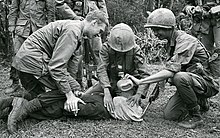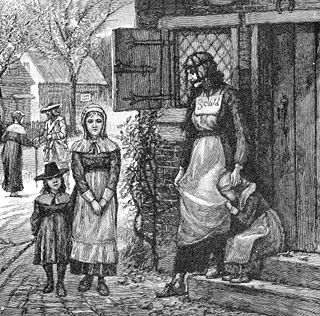
A scold's bridle, sometimes called a witch's bridle, a gossip's bridle, a brank's bridle, or simply branks, was an instrument of punishment, as a form of public humiliation. It was an iron muzzle in an iron framework that enclosed the head. A bridle-bit, about 5 cm × 2.5 cm in size, was slid into the mouth and pressed down on top of the tongue, often with a spike on the tongue, as a compress. It functioned to silence the wearer from speaking entirely, to prevent the women from nagging. The scold's bridle was used on women. This prevented speaking and resulted in many unpleasant side effects for the wearer, including excessive salivation and fatigue in the mouth. For extra humiliation, a bell could also be attached to draw in crowds. The wearer was then led around town by a leash.

Public humiliation or public shaming is a form of punishment whose main feature is dishonoring or disgracing a person, usually an offender or a prisoner, especially in a public place. It was regularly used as a form of judicially sanctioned punishment in previous centuries, and is still practiced by different means in the modern era.

In the common law of crime in England and Wales, a common scold was a type of public nuisance—a troublesome and angry person who broke the public peace by habitually chastising, arguing, and quarrelling with their neighbours. Most punished for scolding were women, though men could be found to be scolds.

Waterboarding is a form of torture in which water is poured over a cloth covering the face and breathing passages of an immobilized captive, causing the person to experience the sensation of drowning. In the most common method of waterboarding, the captive's face is covered with cloth or some other thin material and immobilized on their back at an incline of 10 to 20 degrees. Torturers pour water onto the face over the breathing passages, causing an almost immediate gag reflex and creating a drowning sensation for the captive. Normally, water is poured intermittently to prevent death; however, if the water is poured uninterruptedly it will lead to death by asphyxia. Waterboarding can cause extreme pain, damage to lungs, brain damage from oxygen deprivation, other physical injuries including broken bones due to struggling against restraints, and lasting psychological damage. Adverse physical effects can last for months, and psychological effects for years. The term "water board torture" appeared in press reports as early as 1976.

Ducking stools or cucking stools were chairs formerly used for punishment of disorderly women, scolds, and dishonest tradesmen in medieval Europe and elsewhere at later times. The ducking-stool was a form of wymen pine, or "women's punishment", as referred to in Langland's Piers Plowman (1378). They were instruments of public humiliation and censure both primarily for the offense of scolding or backbiting and less often for sexual offences like bearing an illegitimate child or prostitution.
Tickle torture is the prolonged use of tickling to abuse, dominate, harass, humiliate, or interrogate an individual. While laughter is popularly thought of as a pleasure response, in tickle torture, the one being tickled may laugh whether or not they find the experience pleasant. In a tickling situation, laughter can indicate a panic reflex rather than a pleasure response, and the tickling may be a consensual activity or one that is forced, depending on the circumstances. In a consensual form, tickling may be part of a mutually fulfilling, physically intimate act between partners. However, tickle torture can cause real physical and mental distress in a victim, which is why it has been used as an interrogation method or to simply show dominance over another person.

Prisoner abuse is the mistreatment of persons while they are under arrest or incarcerated. Prisoner abuse can include physical abuse, psychological abuse, sexual abuse, torture, or other acts such as refusal of essential medication, and it can be perpetuated by either fellow inmates or prison faculty.
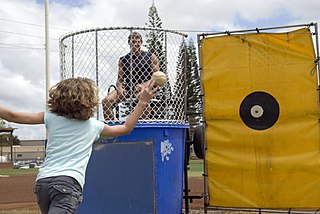
A dunk tank, also known as a dunking booth or dunking machine, is a common feature at Canadian and American fairs, fundraisers, and celebrations. It involves at least two participants, one of whom sits on a collapsible bench above a human-sized water tank. The other participant's objective is to throw a ball at an accompanying target, which if successfully struck, causes the seat to collapse, "dunking" the person into the water. People often volunteer to be dunked while fully dressed. The person throwing the ball often has to pay per throw as donation to a charitable cause or company the dunked person supports or is employed for.
Extrajudicial prisoners of the United States, in the context of the early twenty-first century War on Terrorism, refers to foreign nationals the United States detains outside of the legal process required within United States legal jurisdiction. In this context, the U.S. government is maintaining torture centers, called black sites, operated by both known and secret intelligence agencies. Such black sites were later confirmed by reports from journalists, investigations, and from men who had been imprisoned and tortured there, and later released after being tortured until the CIA was comfortable they had done nothing wrong, and had nothing to hide.
There are cases, both documented and alleged, that involve the usage of torture by members of the United States government, military, law enforcement agencies, intelligence agencies, health care services, and other public organizations both in and out of the country.
"Enhanced interrogation techniques" or "enhanced interrogation" was a program of systematic torture of detainees by the Central Intelligence Agency (CIA), the Defense Intelligence Agency (DIA) and various components of the U.S. Armed Forces at remote sites around the world—including Bagram, Guantanamo Bay, Abu Ghraib, and Bucharest—authorized by officials of the George W. Bush administration. Methods used included beating, binding in contorted stress positions, hooding, subjection to deafening noise, sleep disruption, sleep deprivation to the point of hallucination, deprivation of food, drink, and medical care for wounds, as well as waterboarding, walling, sexual humiliation, rape, sexual assault, subjection to extreme heat or extreme cold, and confinement in small coffin-like boxes. A Guantanamo inmate's drawings of some of these tortures, to which he himself was subjected, were published in The New York Times. Some of these techniques fall under the category known as "white room torture". Several detainees endured medically unnecessary "rectal rehydration", "rectal fluid resuscitation", and "rectal feeding". In addition to brutalizing detainees, there were threats to their families such as threats to harm children, and threats to sexually abuse or to cut the throat of detainees' mothers.
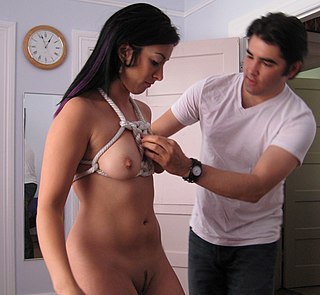
Breast torture is a BDSM activity in which sexual stimulation is provided through the intentional application of physical pain or constriction to the breasts, areolae or nipples of a submissive. It is a popular activity among the kink community. The recipient of such activities may wish to receive them as a result of masochism or they may have a desire to please a dominant who is sadistic. Those involved may also be motivated by breast fetishism. Mild breast torture such as light impact play on the breasts is also occasionally used outside of the BDSM context to provide stimulation and pleasure during conventional sex. While breast and nipple torture is usually performed on women, most techniques or methods may also be used on men.
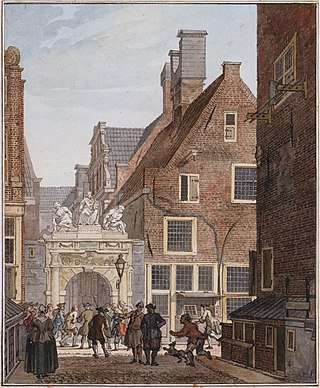
The Rasphuis was a "tuchthuis" or prison in Amsterdam that was established in 1596 in the former Convent of the Poor Clares on the Heiligeweg. In 1815 it was closed, and in 1892 the building was demolished to make way for a swimming pool. On the site today is the Kalvertoren shopping centre.

The Coney Island waterboarding thrill ride was a work in Coney Island, Brooklyn, New York City conceived by conceptual artist Steve Powers in mid-2008.

Water cure is a form of torture in which the victim is forced to drink large quantities of water in a short time, resulting in gastric distension, water intoxication, and possibly death.
Lutfi al-Arabi al-Gharisi is a citizen of Tunisia held in detention by the United States.

Human rights abuses in Chile under Augusto Pinochet were the crimes against humanity, persecution of opponents, political repression, and state terrorism committed by the Chilean Armed Forces, members of Carabineros de Chile and civil repressive agents members of a secret police, during the military dictatorship of Chile under General Augusto Pinochet from 1973 to 1990.
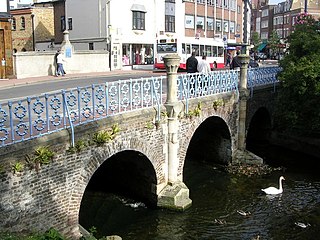
The Clattern Bridge is a bridge over the Hogsmill River in Kingston upon Thames. It was built around 1175 and is thus one of the oldest intact bridges in England. It replaced an older Saxon bridge which was known as the Clatrung Bridge. Its various names, such as the Clateryngbrugge, are thought to derive from the clattering of horses' hooves as they crossed the bridge. The bridge still carries a full load of modern vehicle traffic.
